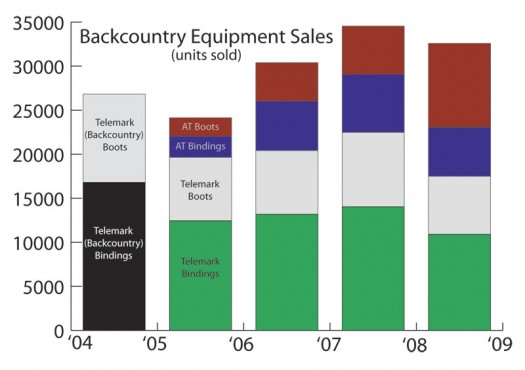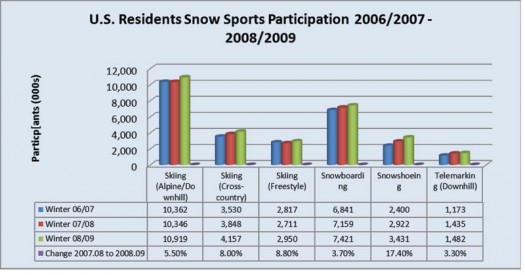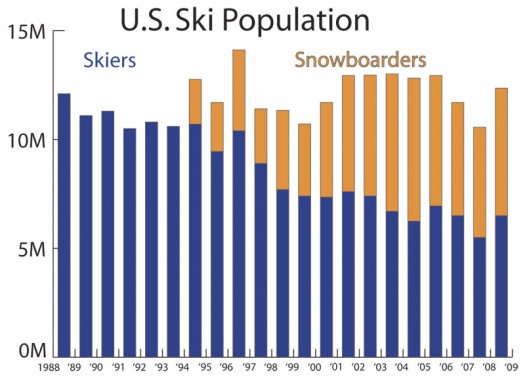A copy of the Ski Industries of America Intelligence Report for 2009 arrived at my doorstep a while back. In the opening pages there is a headline suggesting reasons for optimism. After careful study of their numbers I would agree, but not necessarily for the same reasons.
There is no way I think the folks at SIA are deliberately deceitful, but due to how they categorize different snowsports as well as how they gather numbers, the veracity of their take has been suspect for many years. Paul Parker, author of “Free-Heel Skiing” and a major player in the promotion and development of backcountry skiing products reminded me that SIA’s “numbers reflect only what their members wish to give them, and their membership doesn’t fully represent” the outdoor sector. In other words, historically there is data missing from SIA’s numbers.
Even so, glimmers of reality are reflected in the SIA reporting. One of the key claims for optimism is a recent uptick in alpine skiing after a relentless 20-year decline (see graph near end of this article). The low point for alpine skiing was 07/08 with only 5.5 million skiers that season. Snowboarding hit a relative low that year too, and both rebounded in 08/09. One year of growth is encouraging, but not a strong basis for optimism. Even so, there is plenty of good news in this report, especially for backcountry skiers who like to see their sport grow. (Yeah, not everyone likes growth, but you have to admit it has possible and frequently concrete benefits such as better gear, more huts, more access opportunities, etc.)
The first place I looked in the report was to see how equipment sales were doing in the backcountry realm. As expected, the growth in alpine touring (randonnee, AT) was dramatic. Prior to 2006 AT equipment numbers were hidden, either misappropriated as telemark which was then considered synonymous with backcountry, or buried in alpine resort numbers. So prior to ’06 AT numbers are non-existent. Since then, however, the numbers have done nothing but grow. By SIA’s accounting AT boot sales exceeded teleboot sales for the first time ever in 2009. From my conversations with major specialty retailers that benchmark most probably occurred in 07 or 08, but at least SIA has the trend correct.

This graph combines six reports for unit sales of telemark and alpine touring equipment. I did not include numbers for the sale of skis since many backcountry skiers used models marketed to the general resort crowd rather than backcountry specific boards. Only numbers for boot and binding sales were included. Six reports were provided, breaking out sales via specialty shops, chain stores, and the internet. Interestingly, specialty shops do not include outdoor shops so there is a lot of data missing here, but I believe the trend this data indicates does reflect reality. Also, prior to 2006 the term telemark included sales of AT gear, so the data for the 04/05 year does not include the breakout of AT equipment.
The most surprising data related to telemark equipment sales is for the past three to four years retailers have been mumbling “tele is dead.” Not according to SIA though. It is true that tele equipment sales probably peaked around 2005, give or take a year, but telemark is far from dead.
Looking at SIA numbers for combined boot and binding sales for AT and telemark indicates that tele is still the dominant discipline in the backcountry. I know from seeing what people use in the backcountry that CANNOT BE TRUE. A quick check with boot manufacturers confirmed that yes, AT is the dominant gear they’re selling — but telemark is still kicking just fine.
Black Diamond’s Tomas Laakso, product manager for their ski line says the percentage of AT skiers in the Wasatch is at least 75%, maybe higher.
Gordon Bailey, president of Garmont USA said that even though AT sales were Garmont’s strong suit, “tele is still super active. I had to re-order NTN bindings three times last year to keep up with sales.”
According to Chris Clark, sales manager for Scarpa USA, “Tele is doing just fine. It’s still accounts for the majority of our ski boot sales, but not by as much as it used to.”
Exactly what is the ratio of AT to tele skiers? I figured a call to Adam Howard, editorial director for Backcountry magazine could answer that. Except he couldn’t. His take was as anecdotal as everyone else’s, with tele being stronger back east, but no longer the dominant gear of choice.
That led to the bigger question. Just how big has the sport of backcountry skiing become?
Nevermind how many use training heels for turning, or use cable bindings that are really not that much different from ski bindings of half a century ago. In other words, forget the tele versus AT numbers debate. The more important question is how many of us are there out there earning our turns? Howie didn’t know, but together we reasoned it was in the neighborhood of half a million skiers.
Then I went back and started writing up this report for WildSnow and in the process of double checking those pesky numbers it hit me between the eyes, right there in the midst of SIA’s sometimes dubious statistics in their end of season summary for 2009/10. It was the last graph (see below) indicating US Participation in Snow Sports from 2006 to 2009.
The actual numbers SIA promulgates are unbelievable, with claims of over 10 million alpine skiers in 07, 08, and 09. The most ludicrous number of all was more than 1 million telemark skiers. I’ve tracked the growth of tele for almost twenty years and my conversation with Howie only confirmed my gut that we’re actually near the half million mark — definitely not twice that. But the graphs below, as erroneous as the actual numbers may be (or not), provided something I could believe, which is the relative proportion of backcountry skiers to snow sliders in general.

This graph is from SIA’s Season Ending Summary for 2009/10. According to Kelly Davis, Director of Research at SIA, this data is more accurate than previous years because the survey sample size is more than four times larger. The results are so different my first impression is to say it is less accurate. I can’t say for sure that there are or are not more than 10 million alpine skiers in the US, but I’m confident that results suggesting there are more than 1 million backcountry skiers in the US, let alone telemarkers, is a clear indication something is amiss in the counting department. Again, the trend, or relationship between the tele numbers and alpine numbers does reflect reality.

The numbers shown on this graph combine two from SIA’s 2009 Intelligence report, US participation for alpine skiers and snowboarders. The steady decline in alpine skiing numbers is well known but tends to get projected onto the entire industry. When you combine the numbers it is more obvious that interest in glisse has actually experienced a modest increase over time, not a decrease. This explains the crowding at ski resort parking lots better but not the continual reports of gloomy economic performance.
Keep in mind that at SIA tele has historically been synonymous with backcountry. Using that as the filter to judge this report by, that meant backcountry skiers accounted for around 10% of the total ski population. If you just compare alpine skiers to backcountry skiers, it is around 13.5% (1.5/10.9= 0.1358). If you include snowboarders, it drops to around 8% (1.5/(10.9+7.4)=0.08). If you apply that percentage to the more believable numbers in SIA’s Intelligence Report for 2009, with 6.5 million skiers that meant there are around 650-thousand backcountry skiers; conservatively half a mil, maybe more (ymmv).
No matter how you slice the numbers, backcountry skiing has become more than just the soul of of skiing, it is now a measurable, undeniable force in the industry. Except for those who bemoan the loss of solitude at easy access trailheads, this is good news for everyone.
(Guest blogger Craig Dosite founded and published Couloir Magazine, the first English language publication devoted entirely to backcountry skiing. He’s been a die hard telemarker for years and coined the phrase “earn your turns.” Craig blogs at earnyourturns.com.)
Craig Dostie is well known in the backcountry skiing world as founder and publisher of Couloir Magazine (1990-2007), the publication that led the way in making it legal for mainstream ski magazines to cover subjects other than resort lodging and how-to-snowplow tips. Along the way he coined and promoted the phrase “earn your turns.”
